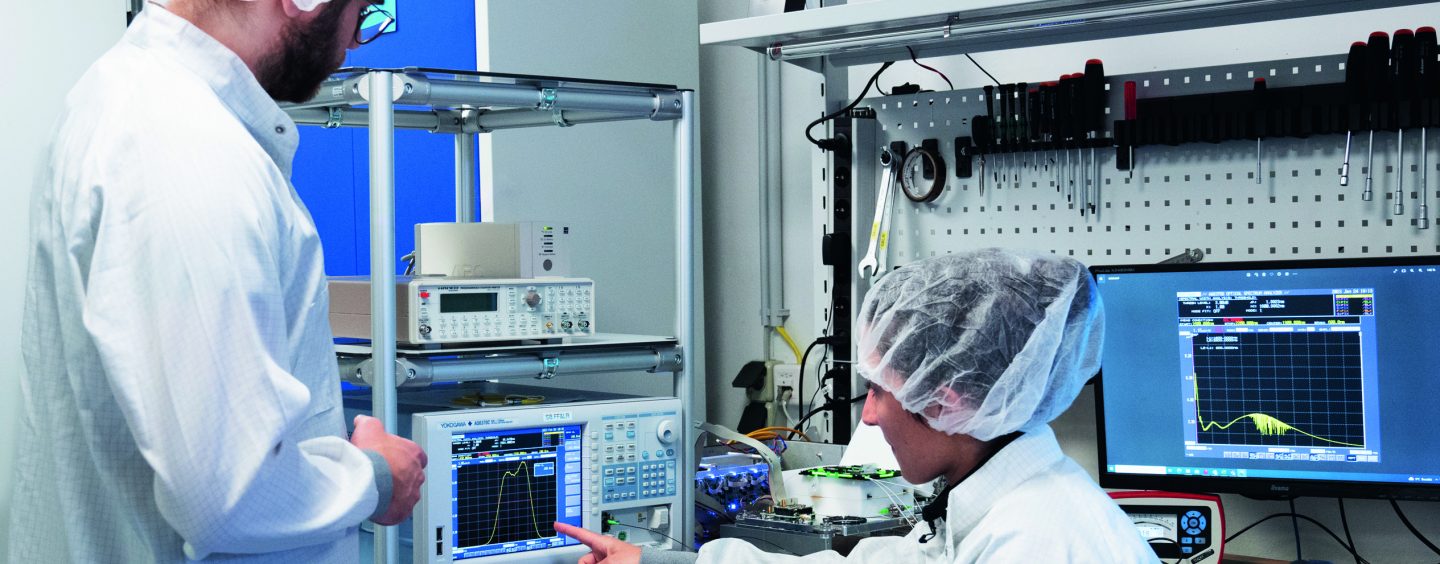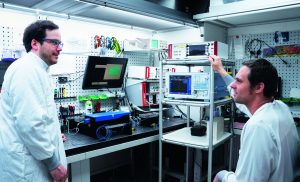
How 100 physicists of laser manufacturer are shaping the future of quantum computing
by Yokogawa Test&Measurement March 25, 2025Planck, Schrödinger and Heisenberg Would Be Proud
It is the skyline of a metropolis that often hints at its distinctive character. Whether New York, Singapore, or Berlin – the first glance often seems chaotic. Only on the second glance do logical structures appear, growing decade by decade. Anyone who is not familiar with quantum technology might feel the same way when looking at an experimental setup from German laser manufacturer TOPTICA Photonics.
One person who is well-versed in the architecture of optomechanics is Dr. Falk-Richard Gerhard Heinz Winkelmann; known to his colleagues as Richard. The 33-year-old is a physicist and application scientist at TOPTICA. Together with more than 100 colleagues, he conducts research using experimental setups on – among other things – high-end laser systems for scientific and industrial applications.
Just like in urban planning, the space in complex systems of quantum technology, such as in quantum computers, becomes scarcer as the demands increase. Many quantum computers are also critically dependent on lasers.
Noise Suppression: The More, the Better
Whether it’s quantum computing or biophotonics, the scientists at TOPTICA have made it their mission to figure out how to technically implement what customers need in the field of laser technology. They see themselves as interface managers between research and industry, and their success is proving them right. Research institutes from around the world turn to TOPTICA to leverage their expertise in light and laser technology.
In addition to CW (continuous wave) lasers, TOPTICA also offers pulsed lasers in its portfolio. For CW lasers, spectral width and background noise are particularly interesting factors. This background noise – also known as ASE (Amplified Spontaneous Emission) – is significantly suppressed in TOPTICA lasers. The suppression of ASE can be measured using Yokogawa spectrum analyzers, which offer a high dynamic range and high resolution. A high dynamic range is essential for measuring ASE suppression, i.e., the spontaneous emission noise. Yokogawa analyzers, which operate based on the Czerny-Turner monochromator principle, can measure suppression levels well above 60 dB.
The high resolution of up to 10 pm is indispensable for displaying the laser line shape. For pulsed lasers, Winkelmann and his colleagues primarily focus on the spectrum. The measurement principle of Yokogawa analyzers is equally suitable for CW lasers and pulsed lasers with various pulse rates. These measurements benefit from both an external trigger input (for pulse measurements ranging from a few Hertz to several hundred Hertz) and additional pulse modes for measuring pulse rates from a few kHz to several hundred kHz.
However, spectrum analyzers are not only used for development purposes. Yokogawa devices are also utilized for alignment, optimization, and characterization in laser manufacturing (images 1 and 2). The applications of TOPTICA lasers are diverse – quantum computing is just one of many fields where lasers are essential.

Laser manufacturing workstation with measurement instruments
Time Well Spent: Differences in Quantum Computing
However, as Dr Winkelman explains, not all quantum computers are the same. There are distinctions between ion-trap quantum computers, photonic quantum computers, and so-called superconducting quantum computers. All of them share the ability to compute in a fundamentally new way – one based on the principles of quantum mechanics.
“The greatest strength of quantum computers comes from the deliberate interference of quantum states. Classical computers cannot do this,” says Winkelmann. However, he emphasizes that not all quantum computers should be lumped together. “If I throw stones into a pool of water, a pattern emerges. This pattern is influenced by the number of stones, their sequence, or their size. Simply put, the water is computing for us. We don’t need to understand it completely; we just need to apply the rules correctly.” In any case, there will always be a pattern in the end – an outcome. Continuing the analogy, instead of water, one could also use a membrane. This illustrates that different physical systems can be used to implement quantum computing.
“The classical computer as we know it operates with ones and zeros,” continues Winkelmann. These can be manually written down if time allows, stored on a silicon chip, or represented by switching light on and off. In short, there are many ways to work with ones and zeros. Similarly, in quantum computing, so-called quantum bits (qubits) also use ones and zeros. However, qubits can also exist in a superposition of both states, “one” and “zero” simultaneously. This property gives them their power for solving particularly complex problems.
The Technology Race Is Far from Decided
According to Dr. Winkelmann’s assessment, every type of quantum computer has potential.
“Whether it`s photonic quantum computers, superconducting qubits, or ion-trap quantum computers: the race between different platforms is still open,”
he explains. It is also unclear how this race will unfold and whether, in the end, it will resemble a decathlon, where each discipline has its own winner
To rapidly develop and establish practical systems, experts from research groups and companies like TOPTICA – one of the world’s leading developers of diode lasers, ultrafast fiber lasers, terahertz systems, and optical frequency combs – are collaborating globally. Winkelmann is just one of many; as he notes, the “physicist density” at TOPTICA is remarkably high. His team alone consists of eight experts, all physicists with backgrounds in quantum physics. They now work in an international team, with colleagues from Germany, India, and the USA. Their job: leveraging a deep understanding of quantum technologies to develop optimal laser and photonics solutions for these applications and advising customers on their implementation.
The high demand from the industry is the strongest indication that TOPTICA’s experts are on the right track. “It’s impressive how rapidly the field of quantum technologies is evolving,” explains Jan Brubacher. As a senior marketing manager at TOPTICA, he predicts that TOPTICA laser systems will play a key role in the commercialization of this cutting-edge technology.
Quantum Leap for Pharmaceutical Research: Simulating Chemical Processes
To achieve this, TOPTICA has built a powerful research and development unit: Nearly 100 people work on improving existing products and developing entirely new ideas. Everyone agrees: “Without team spirit—from mechanical implementation to sourcing the necessary components—nothing works here.”
Brubacher’s argument is supported by the numerous quantum computing research projects involving TOPTICA. He emphasizes that quantum computing should not always be solely associated with faster calculations. A prime example is medicine and pharmaceutical research. Here, quantum simulation can accelerate research, potentially leading to a faster market entry for new medications – drugs that patients often have to wait a long time for today.
Winkelmann, however, finds it important to distinguish between quantum computing and quantum simulation. He offers an easy-to-understand analogy: “There are supercomputers – analogous to quantum computers – that calculate how air flows around a car. And then there are wind tunnels. A quantum simulator is like a wind tunnel.” Simply put, quantum simulation allows researchers to recreate systems that behave exactly like their real-world counterparts.
Winkelmann highlights proteins as an example: “Using quantum simulation, we can accurately model processes within human cells. Reconstructing molecular processes opens up entirely new research possibilities for biochemists.” With quantum simulation, biochemists can simulate chemical processes to quickly predict how individual molecules will behave, offering groundbreaking potential for drug discovery and development.
The Big Idea: Quantum Computing Made in Germany
Winkelmann evidently loves his job: “Since we all have a similar physics background here, we can dive straight into the details.” This level of performance is more important than ever. If research collaborations, consortia, and synergies – such as the partnership between TOPTICA and Yokogawa – prove successful, Germany has a unique opportunity to play a key role in quantum computing as well. That gives reason for optimism.
by Kerstin Jarosch, TOPTICA Photonics


No Comments so far
Jump into a conversationNo Comments Yet!
You can be the one to start a conversation.